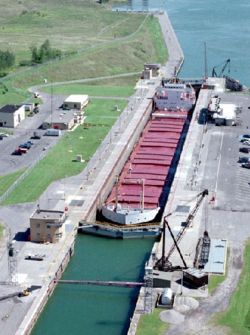Saint Lawrence Seaway
2007 Schools Wikipedia Selection. Related subjects: Air & Sea transport; North American Geography
The St Lawrence Seaway is the common name for a system of canals that permits ocean-going vessels to travel from the Atlantic Ocean to the Great Lakes as far as Lake Superior. Legally it extends from Montreal to Lake Erie, including the Welland Canal and the Great Lakes Waterway. The seaway is named after the Saint Lawrence River, which it follows from the Atlantic Ocean to Lake Ontario.
Route
Beginning in the Saint Lawrence River, the seaway leaves Quebec through Lac Saint-François, passing through the Akwesasne Mohawk First Nation. At Cornwall and Massena, the river and seaway form an international waterway, with Ontario on the northern shore and New York State on the southern shore. Cornwall and Massena are joined by an international bridge over the St. Lawrence, the Seaway International Bridge, named for the seaway.
Between Cornwall and Massena, the seaway diverges south of the river, passing through New York's Wiley-Dondero Canal, containing the Snell and Eisenhower locks. This route bypasses the Moses-Saunders hydroelectric dam before passing through the short Iroquois Lock on the Canadian side of the river, permitting vessels to bypass the Iroquois water level control structure. West of the Iroquois Lock, the seaway follows the St. Lawrence River through the Thousand Islands and into Lake Ontario. Altogether there are seven locks in the Montreal–Lake Ontario section (five Canadian, two American).
The Welland Canal (eight locks) links Lake Ontario (surface elevation 74m) to Lake Erie (surface elevation 173m), bypassing the formidable barrier of Niagara Falls.
West of Lake Ontario in the Great Lakes Waterway the Soo Locks in Sault Ste Marie, Michigan bypass the rapids on the St. Marys River, connecting Lake Superior (surface elevation 183m) with Lake Huron (surface elevation 176m). This short canal is operated toll-free by the U.S. Army Corps of Engineers, not by the joint U.S.-Canada Saint Lawrence Seaway Management Corporation. They are often not considered part of the St. Lawrence Seaway, although they are an integral part of the system.
The seaway was first used on April 25, 1959, although it was not officially opened until June 26, 1959, by Queen Elizabeth II and President Dwight D. Eisenhower.
To create a navigable channel through the Long Sault rapids and to allow hydroelectric stations to be established immediately upriver from Cornwall, Ontario and Massena, New York, an artificial lake had to be created. Called Lake St. Lawrence, it required the flooding on July 1, 1958 of ten villages in Ontario, now collectively known as " The Lost Villages". There was also inundation on the New York side, but no communities were affected. At the time of its construction, the seaway project was considered by some to be the largest work of engineering of all time.
The creation of the seaway also led to the introduction of foreign species of aquatic animals, including the sea lamprey and the zebra mussel, into the Great Lakes watershed.
The seaway provides significant entertainment and recreation such as boating, camping, fishing, and scuba diving. Of particular note is that the seaway provides a number of divable wrecks within recreational scuba limits (shallower than 130 ft.). Surprisingly, the water temperature can be as warm as 70°F with little or no thermocline during the mid to late summer months.
Lock and channel dimensions
The size of vessels that can traverse the seaway is limited by the size of locks. Locks on the St Lawrence and on the Welland Canal are 766 feet (233.5 m) long, 80 feet (24 m) wide, and 30 feet (9.1 m) deep. The maximum allowed vessel size is slightly smaller: 740 feet (225.6 m) long, 78 feet (23.8 m) wide, and 26 feet (7.9 m) deep; many vessels designed for use on the Great Lakes following the opening of the seaway were built to the maximum size permissible by the locks, known informally as Seaway-Max. Large vessels of the lake freighter fleet are built on the Lakes and cannot travel down the seaway to the ocean. The only lock on the Great Lakes Waterway is 1,200 feet (357 m) long, 110 feet (33.5 m) wide and 32 feet (9.8 m) deep, but the channels are not kept that deep.
Water depth is another obstacle to vessels, particularly in connecting waterways such as the St Lawrence River. The depth in the channels of the seaway is 41 feet (12.5 m) downstream of Quebec City, 35 feet (10.7 m) between Quebec City and Deschaillons, 37 feet (11.3 m) to Montreal, and 28 feet (8.2 m ) upstream of Montreal. Channels in the Great Lakes Waterway are slightly shallower: 25 to 27 feet (7.62 to 8.2 m).
Channel depths and limited lock sizes mean that only 10% of ocean-going ships can traverse the entire seaway. Proposals to expand the seaway, dating from as early as the 1960s, have been rejected as too costly, and environmentally and economically unsound. Lower water levels in the Great Lakes have also posed problems for some vessels in recent years.
Earlier canals
In 1862, locks on the St Lawrence allowed transit of vessels 186 feet (57 m) long, 44½ feet (13.6 m) wide, and 9 feet (2.7 m) deep. The Welland Canal at this time allowed transit of vessels 142 feet (43 m) long, 26 feet (7.9 m) wide, and 10 feet (3.0 m) deep. These were generally too small to allow passage of larger ocean-going ships.
